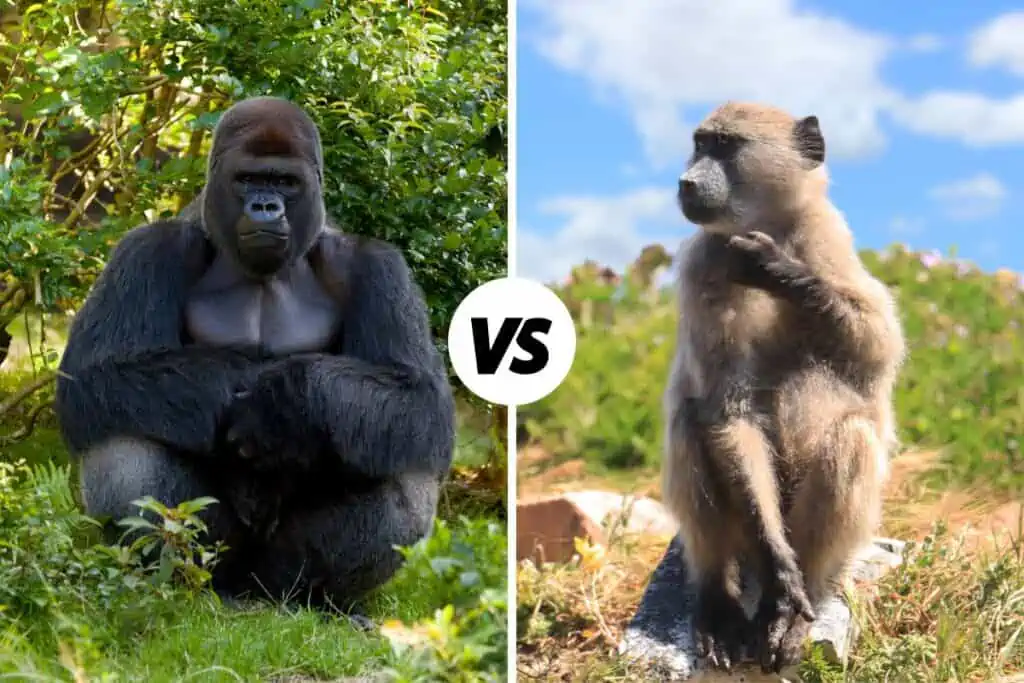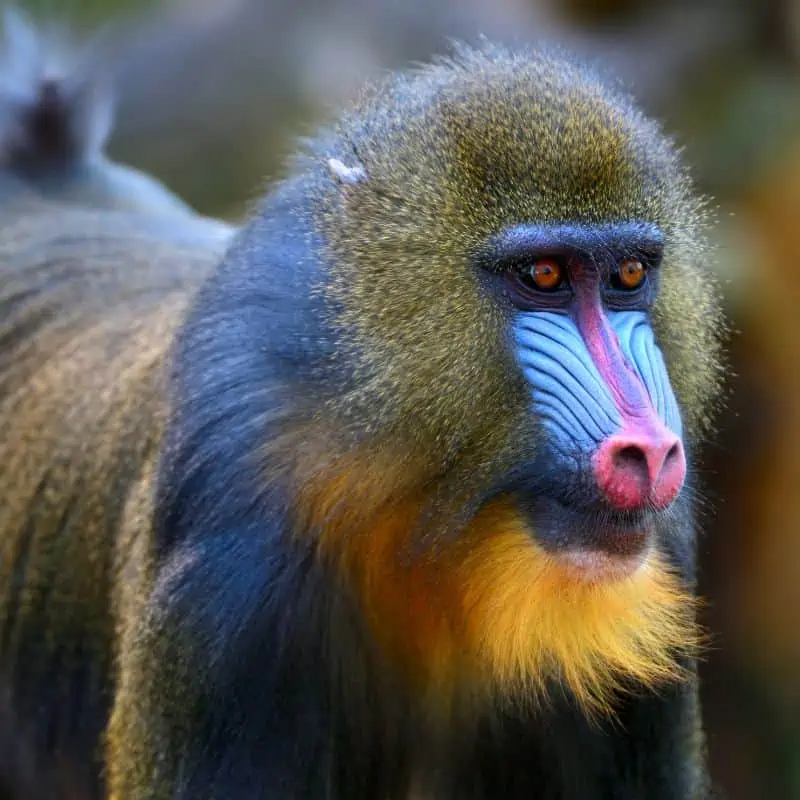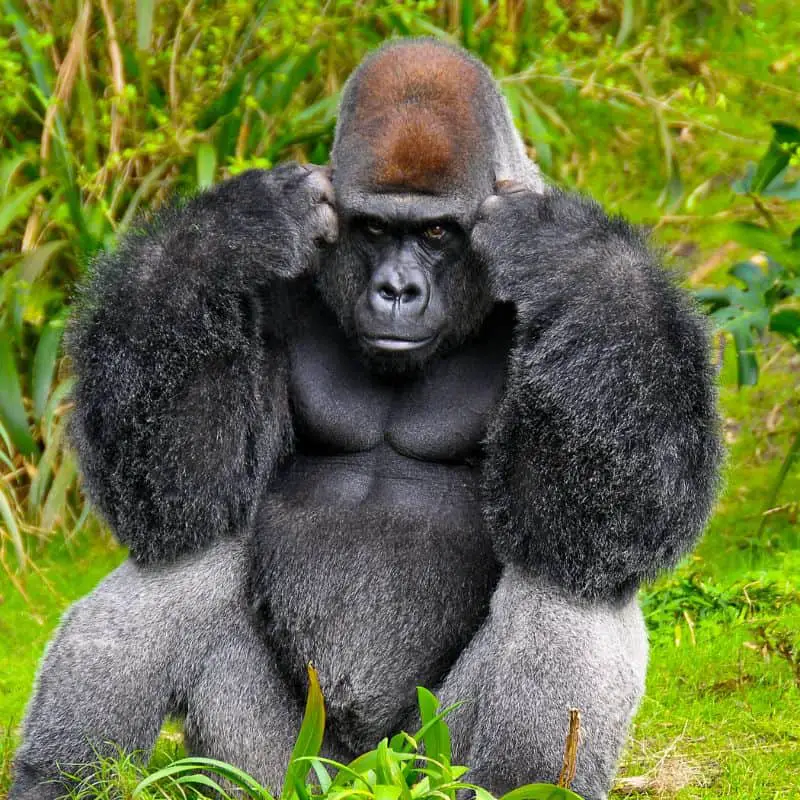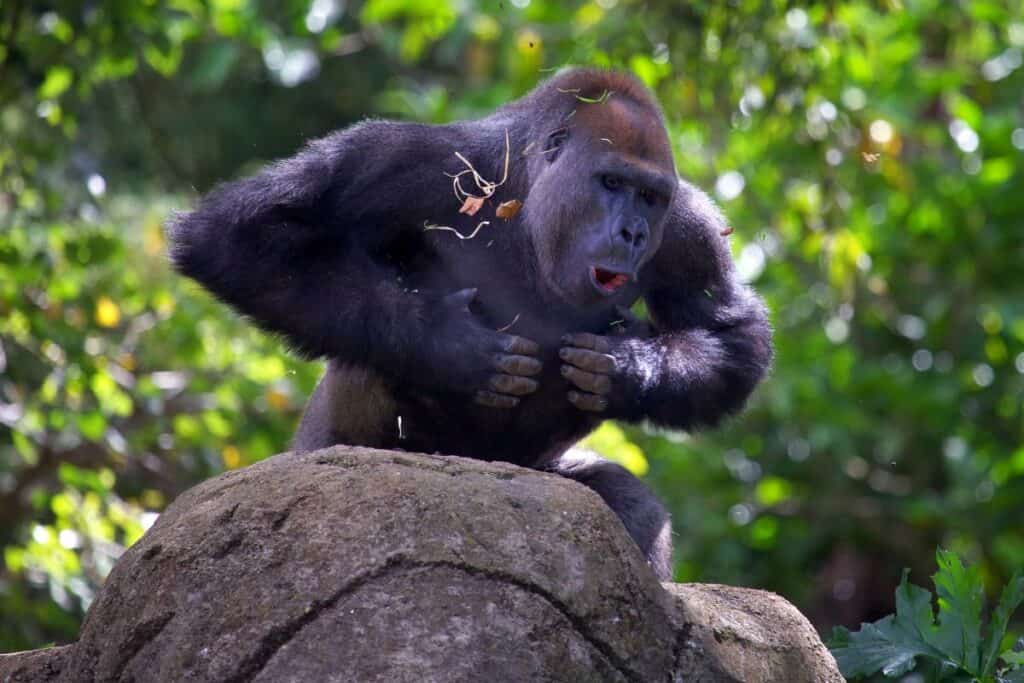There is a lot of confusion about the difference between gorillas and monkeys. This is understandable, as the two creatures share many similarities. So, are gorillas monkeys?
Gorillas, along with humans, chimpanzees, orangutans, and gibbons, are all ape species, not monkeys. Baboons, macaques, and capuchins are examples of species of monkeys. Regarding evolution and genetics, apes are more similar to humans than monkeys. However, apes and monkeys are all primates.
The terms “monkey” and “ape” are frequently used interchangeably. But there are definite distinctions between the two. Let’s dive into the differences.

- Are gorillas monkeys?
- Distinguishing between gorillas and monkeys
- Gorillas and other apes do not have tails
- The size and physical aspects of gorillas versus monkeys
- How gorillas move around versus monkeys
- Gorillas are more intelligent than monkeys
- Life expectancy difference between gorillas and monkeys
- Differences in communication between gorillas (and apes) and monkeys
- Where gorillas and monkeys typically live
- Interesting facts about gorillas
- Final thoughts on gorillas and monkey differences
Are gorillas monkeys?
Before examining the differences, it is critical to know that gorillas and monkeys are both primates.
On Earth, there are more than 300 species of primates, including humans, other apes, monkeys, and prosimians like lemurs. Hands, feet that resemble hands, and forward-facing eyes set primates apart from other species.
Most primates, possibly except for many humans, are nimble tree-dwellers.
Most gorillas are ground-dwelling great apes living mainly in equatorial Africa’s tropical forests. Depending on their DNA makeup, most gorillas’ and humans’ DNA share 95 to 99% similarity.
Even though gorillas are, in fact, not only apes but are categorized as one of the great apes, many people mistakenly believe they belong to the monkey family.
This is understandable as they share some similar traits; however, there are various distinctions between apes (thus meaning gorillas) and monkeys. There is cause for confusion, as even scientific classifications have changed over time.

Given that lemurs and gorillas, for example, are both classed as primates, it can initially seem unclear that there are essential distinctions among the numerous varieties of primates.
However, physical traits and long-term evolutionary development can explain most variations.
The primate order has numerous subcategories, such as prosimians, monkeys, and apes. Do not feel foolish if you mistake a prosimian for an ape; additionally, to add to the confusion, most primates you encounter are monkeys.
If you struggle to tell the difference, then remembering this will help: if the primate you are trying to identify is not a lemur, loris, or tarsier (a gorilla, chimpanzee, human, bonobo, orangutan), then it is a monkey.
While there are many different species of monkeys, there are only a few species of apes and even fewer types of gorillas.
Distinguishing between gorillas and monkeys
Now that you are more aware that gorillas are not, in fact, monkeys but rather the largest type of ape on the planet, we are going to delve further into the differences between apes (particularly gorillas) and monkeys.
Gorillas and other apes do not have tails
Searching for a tail is the quickest and most straightforward way to distinguish between monkeys, gorillas, and other apes.
The majority of monkey species have tails, but gorillas do not.

The size and physical aspects of gorillas versus monkeys
In general, apes (undoubtedly including gorillas) are larger than monkeys and have a body shape and skeleton that are far more similar to humans than monkeys.
Monkey skeletons frequently resemble those of smaller, four-legged mammals like cats and dogs.
Additionally, all apes (including gorillas) have appendices, while monkeys do not, even though this distinction cannot be made by sight.
Most of the time, apes, especially gorillas, are heavier than monkeys, with broad chests and shoulder joints that let them swing through trees.
The male gorilla is the largest ape, weighing roughly 500 pounds, while the male mandrill is the biggest monkey, weighing around 120 pounds.

How gorillas move around versus monkeys
While many apes use their arms to swing from branch to branch, gorillas tend to stay on the ground.
Monkeys run along branches when moving through trees (a form of movement known as brachiating).
Gorillas are more intelligent than monkeys
Apes, especially the like of gorillas, have bigger brains than monkeys. Gorillas and other apes tend to have a higher level of intelligence than monkeys.
And therefore, most ape species are capable of using some form of tool, which we will discuss below.
Gorillas and other ape species are highly intelligent and capable of acting in ways reminiscent of human behavior and sharing basic bodily structures with humans.
For instance, chimpanzees, who are genetically closest to humans, can make and use simple tools.
This is a remarkable feature that sets apes apart from not only other primates but mammals in general.

Life expectancy difference between gorillas and monkeys
In general, gorillas also have longer life expectancies than monkeys do.
The average lifespan for most gorillas is 35-40 years, while you will find that most monkeys only live for roughly 20 years (with certain exceptions, such as the Guinea baboon, which can live for between 35-45 years).
Differences in communication between gorillas (and apes) and monkeys
Even though monkeys can communicate, gorillas have more developed cognitive and linguistic abilities.
Despite being unable to speak like humans, they can effectively communicate with people using sign language and other body movements.
Gorillas, chimpanzees, and bonobos can form complex social groups and even display some aspects of culture thanks to their communication abilities.
Apes can reason and find solutions to issues in their environments, just like humans.

Where gorillas and monkeys typically live
Geographically speaking, monkeys live in Africa, Asia, Central America, and South America, while apes are mainly restricted to Africa and Asia in the wild.
There are also more significant population numbers of monkey species than apes, especially gorillas.
Interesting facts about gorillas
we thought you might be interested to find out some further information about gorillas, including their diet and behavior.
Gorilla eating habits
Gorillas primarily consume fruits, bamboo shoots, and stems as part of their vegetarian diet.
However, western lowland gorillas enjoy eating ants and termites and will crack open termite nests to consume the larvae.
Gorilla chest-beating
Most people are probably aware of gorilla chest-beating, but are you proficient at it? Many may have tried to imitate a chest beat with closed fists, but real gorillas never do this.
If you pay close attention to footage of a gorilla chest-beating, you will notice that they make the recognizable noise using the palms of their hands.
Doing the chest beat with their palms rather than their fists reduces the risk of injury and produces a louder sound that carries further, especially in the jungles.
Gorillas are not very aggressive creatures
Due to their calm nature, gorillas are known as “gentle giants.”
Understand, though, that gorillas are stronger than most people, so if they wanted to, they could easily harm us.
You are more likely to experience a peaceful encounter with a gorilla if you maintain distance, avoid eye contact, and do not act threateningly.
Gorillas and other apes do not make ideal pets
When you see images of young primates, particularly gorillas, you might think they look remarkably adorable and would love the idea of having one as a pet.
Gorillas and other primates, however, are terrible pets for various reasons.
Most have sharp teeth and are more powerful than the typical person, making them easily able to cause harm.
Primates that are separated from their peers frequently suffer psychological harm because they depend on their social groups’ interactions to survive.
They have behaviors you probably would not want in your home, such as urine washing to mark their territory. And they can be challenging to take care of and need special diets.

Final thoughts on gorillas and monkey differences
A group of primates collectively referred to as apes include humans, chimpanzees, bonobos, orangutans, gorillas, gibbons, and members of the superfamily Hominoidea.
The family Hominidae also referred to as the great apes, is a subfamily of the superfamily Hominoidea.
Gorillas and other apes are classified as great apes; therefore, they are not considered monkeys.
